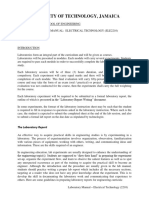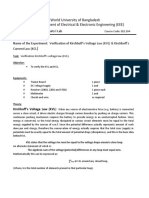Experiment 3: To Verify Kirchhoff's Voltage and Current Laws Experimentally
Experiment 3: To Verify Kirchhoff's Voltage and Current Laws Experimentally
Uploaded by
Waseem HaiderCopyright:
Available Formats
Experiment 3: To Verify Kirchhoff's Voltage and Current Laws Experimentally
Experiment 3: To Verify Kirchhoff's Voltage and Current Laws Experimentally
Uploaded by
Waseem HaiderOriginal Title
Copyright
Available Formats
Share this document
Did you find this document useful?
Is this content inappropriate?
Copyright:
Available Formats
Experiment 3: To Verify Kirchhoff's Voltage and Current Laws Experimentally
Experiment 3: To Verify Kirchhoff's Voltage and Current Laws Experimentally
Uploaded by
Waseem HaiderCopyright:
Available Formats
Electric Circuit lab
Experiment 3: To verify Kirchhoff’s voltage and current laws experimentally.
Student learn
How to patch resistive circuits and verify KVL/KCL for each of them.
Pre-Lab Assignment: For the circuit shown in fig 1, calculate:
1. VAB , VBC ,VAD ,VDG , VBD And VAC
2. I1 , I2 ,I3 , I4 and I5
(You can choose any value for R1, R2, R3 and R4)
Apparatus
Breadboard
Digital Multimeter DMM
Power supply
Resistors
Theory
1. Check the values of the resistors, to be used in circuit of fig 1, using Multimeter. Record the
values in table1.
2. Connect the circuit as shown, and have it checked by the instructor. Adjust supply voltage Vs to
5v and check it using dc voltmeter.
3. Measure VAB, VBC, VAD, VDG, VBD and VAC voltages. Record their values (including the signs) in table
2.
4. Measure the current I1, I2, I3, I4 and I5 and record their values (including the signs) in table 3.
EE 100 Electric circuits (Fall 2016) 1
Electric Circuit lab
Observation and Calculations
Resistor values Table 1:-
Resistor R1 R2 R3 R4
Nominal values
Ohmmeter
reading
Voltages Table 2:-
Voltage VAB VBC VAD VDC VBD VAC
Theoretical
experimental
% error
Currents Table 3:-
Current I1 I2 I3 I4
Theoretical
experimental
% error
Extra Task: if you have successfully done with all laboratory tasks, implement the circuits in fig 2 and
verify KCL for each and every loop and KCL for each node and record the readings.
EE 100 Electric circuits (Fall 2016) 2
Electric Circuit lab
Laboratory Report
1. Fir the circuit in fig 1. Verify KCL by adding the experimental values of voltages around the loops.
a. ABCEFA
b. ABDA
c. CDAC
2. For the same circuit verify KCL by adding the experimental values of current at nodes:
a. A
b. B
c. C
3. Do the experimental and theoretical values of voltages and current agree? Indicate the
percentage of differences.
4. Give possible reasons for any discrepancies
5. If you have implemented the circuit in Fig 2 in the lab, draw all the table values showing the
measurement that you have taken and also calculate all those parameter.
EE 100 Electric circuits (Fall 2016) 3
You might also like
- Urdaneta City University College of Engineering and ArchitectureDocument10 pagesUrdaneta City University College of Engineering and Architecturezed cozNo ratings yet
- EE204 LabDocument37 pagesEE204 LabKrishnaveni Subramani SNo ratings yet
- Circuit Analysis LabDocument34 pagesCircuit Analysis LabveeraNo ratings yet
- EE131.1 LabDocument40 pagesEE131.1 LabMarc MontillaNo ratings yet
- Electrical Technology Ele2210Document28 pagesElectrical Technology Ele2210ncasciousNo ratings yet
- EXP. 2 Series DC CircuitDocument4 pagesEXP. 2 Series DC CircuitghlafhlyNo ratings yet
- Lab 2Document6 pagesLab 2HAMM3TNo ratings yet
- Open Ended Lab PhyDocument4 pagesOpen Ended Lab PhySaeed KhanNo ratings yet
- Experiment 2 - KVL - KCLDocument3 pagesExperiment 2 - KVL - KCLDhadkane Azad HainNo ratings yet
- Some Practical Laboratory ExperimentsDocument15 pagesSome Practical Laboratory ExperimentsZwinky ManlaiNo ratings yet
- Star DeltaDocument7 pagesStar DeltagopikrishnaraoNo ratings yet
- Exp 2 Series DC CircuitsDocument4 pagesExp 2 Series DC Circuitsmaskrasheed777No ratings yet
- Lab Manual I Sem Basic ElectricalDocument48 pagesLab Manual I Sem Basic ElectricalGoutami T SunthankarNo ratings yet
- BEE Lab ExpDocument17 pagesBEE Lab ExpShahid AdnanNo ratings yet
- ENGR2200 Lab Manual Lab2Document12 pagesENGR2200 Lab Manual Lab2Sure TipsNo ratings yet
- ET304A Electric Circuits Laboratory Lab 1 Kirchhoff's Voltage and Current LawsDocument4 pagesET304A Electric Circuits Laboratory Lab 1 Kirchhoff's Voltage and Current LawsJoshua MendozaNo ratings yet
- Experiment # 2Document4 pagesExperiment # 2majorskNo ratings yet
- Lab#2 OpAmps 110921 V1Document5 pagesLab#2 OpAmps 110921 V1FrenkiNo ratings yet
- MBU BEEE Lab MergedDocument53 pagesMBU BEEE Lab MergedgaganseekerNo ratings yet
- Lab1-Week 3aDocument4 pagesLab1-Week 3apropigismeNo ratings yet
- Expt 5Document2 pagesExpt 5Tharan VPNo ratings yet
- Lab 5 - Kirchhoff's Laws, Mesh and Nodal Analysis - 230103 - 154435Document6 pagesLab 5 - Kirchhoff's Laws, Mesh and Nodal Analysis - 230103 - 154435Mohammed A. ElsayedNo ratings yet
- Lab#2 OpAmps 110420 V7Document4 pagesLab#2 OpAmps 110420 V7FrenkiNo ratings yet
- Lab #1Document25 pagesLab #1Ryan Shea0% (2)
- Lab 3 Resistor Circuits and Their Faults ــــــــــــــــــــــــــــــــــــــــــــــــــــــــــــــــــــــــــــــــــــــــــــــــــــــــــ ObjectivesDocument6 pagesLab 3 Resistor Circuits and Their Faults ــــــــــــــــــــــــــــــــــــــــــــــــــــــــــــــــــــــــــــــــــــــــــــــــــــــــــ ObjectivesHAZNo ratings yet
- Experimental report LC1 THÂN NGỌC SƠN 20195813Document24 pagesExperimental report LC1 THÂN NGỌC SƠN 20195813Hoàng SơnNo ratings yet
- Lab 3Document8 pagesLab 3TOP 5 GHOSTNo ratings yet
- Engr 2001-Circuits I Lab Laboratory Experiment 2 Voltage and Current Division Reference: ObjectiveDocument4 pagesEngr 2001-Circuits I Lab Laboratory Experiment 2 Voltage and Current Division Reference: ObjectiveJonathan MischNo ratings yet
- Network Analysis and Simulation LaboratoryDocument33 pagesNetwork Analysis and Simulation Laboratoryswis29No ratings yet
- World University of Bangladesh Department of Electrical & Electronic Engineering (EEE)Document5 pagesWorld University of Bangladesh Department of Electrical & Electronic Engineering (EEE)NickNo ratings yet
- Experiment 4: To Verify Current Divider Rule and Voltage Divider RuleDocument7 pagesExperiment 4: To Verify Current Divider Rule and Voltage Divider RuleWaseem HaiderNo ratings yet
- Group 5 - Laboratory No. 5Document14 pagesGroup 5 - Laboratory No. 5Angel GonzalesNo ratings yet
- Report On Basic Ohm S Law Series and Parallel Circuits PDFDocument18 pagesReport On Basic Ohm S Law Series and Parallel Circuits PDFhaikal100% (1)
- Exp 1: SCR SwitchDocument4 pagesExp 1: SCR Switchprop_kcpNo ratings yet
- Lab 3 (Nodal Analysis)Document8 pagesLab 3 (Nodal Analysis)anon_938313424No ratings yet
- Lab Act 2Document11 pagesLab Act 2Jaymar TrimillosNo ratings yet
- Eca Lab Manual Experiment Wise ListDocument44 pagesEca Lab Manual Experiment Wise ListNagendra CNo ratings yet
- 03 ELE1002 Lab3 Intro To SuperpositionDocument6 pages03 ELE1002 Lab3 Intro To SuperpositionÏbhéèDre Thïïnfàllible MorrisonNo ratings yet
- Eet 3251 - LabsDocument17 pagesEet 3251 - LabsEG209/108489/21 ISAAC DUNCAN MWENDWANo ratings yet
- Experiment 3 Duran ZanderDocument8 pagesExperiment 3 Duran ZanderFreos VinciNo ratings yet
- Basic Electrical Laboratory EEL108A 19Document50 pagesBasic Electrical Laboratory EEL108A 19P SNo ratings yet
- ME 530.241: Electronics and Instrumentation Lab 1: Basic Resistor Circuits and DC PowerDocument9 pagesME 530.241: Electronics and Instrumentation Lab 1: Basic Resistor Circuits and DC PowerDhananjay KadamNo ratings yet
- Berl1125 Elect CCT Lab1 23 GroupDocument8 pagesBerl1125 Elect CCT Lab1 23 Groupdh4smdndy6No ratings yet
- Lab 04 - KVL, KCL, Nodal AnalysisDocument9 pagesLab 04 - KVL, KCL, Nodal Analysismatteo rossiNo ratings yet
- Laboratory 5: Kirchhoff's Voltage and Current LawsDocument6 pagesLaboratory 5: Kirchhoff's Voltage and Current LawsSabine CrihanNo ratings yet
- DC Circuit: Laboratory ManualDocument4 pagesDC Circuit: Laboratory ManualJigar SoniNo ratings yet
- Electrical Circuit Lab Report 1Document12 pagesElectrical Circuit Lab Report 1IzaNo ratings yet
- Phy150 Lab 3 DC Circuit (Sabah)Document28 pagesPhy150 Lab 3 DC Circuit (Sabah)Izz002No ratings yet
- Lab FinalDocument21 pagesLab FinalG ManNo ratings yet
- Experiment#2: TheoryDocument5 pagesExperiment#2: TheorySarem AlemuNo ratings yet
- Experiment 2Document5 pagesExperiment 2Benedict DiwaNo ratings yet
- Uso de ProtoboardDocument6 pagesUso de ProtoboardIngeniería Mecánica EléctricaNo ratings yet
- Laboratory Activity No. 3 AC Circuits Series RLC CircuitDocument5 pagesLaboratory Activity No. 3 AC Circuits Series RLC CircuitBe Fit ProgrammingNo ratings yet
- Prelab Exp2 2103Document3 pagesPrelab Exp2 2103امجد ابو حسانNo ratings yet
- Eep Practical File: IndexDocument17 pagesEep Practical File: IndexAkash GandharNo ratings yet
- Design of Electrical Circuits using Engineering Software ToolsFrom EverandDesign of Electrical Circuits using Engineering Software ToolsNo ratings yet
- VSC-FACTS-HVDC: Analysis, Modelling and Simulation in Power GridsFrom EverandVSC-FACTS-HVDC: Analysis, Modelling and Simulation in Power GridsNo ratings yet
- Electromagnetic Compatibility (EMC) Design and Test Case AnalysisFrom EverandElectromagnetic Compatibility (EMC) Design and Test Case AnalysisNo ratings yet
- ANSYS Mechanical (Workbench) Tips - Bonded Contact Between Shell FacesDocument12 pagesANSYS Mechanical (Workbench) Tips - Bonded Contact Between Shell FacesMariusz MilewskiNo ratings yet
- ME2307 Lab ManualDocument14 pagesME2307 Lab ManualAnirudhan RaviNo ratings yet
- Gamo Wankam Daniel Coltech UBA18P0174: Good Answer 1mark, Wrong Answer - 1marks, No Answer No MarksDocument2 pagesGamo Wankam Daniel Coltech UBA18P0174: Good Answer 1mark, Wrong Answer - 1marks, No Answer No MarksDanny JrNo ratings yet
- Magnetism of A Degenerate Electron Gas: (Dated: April 21, 2012)Document4 pagesMagnetism of A Degenerate Electron Gas: (Dated: April 21, 2012)Tharake WijenayakeNo ratings yet
- Coutline1533 NewDocument2 pagesCoutline1533 NewKen OhNo ratings yet
- Science (Code No. 086) Classes: IX and X (2020-21) : General InstructionsDocument12 pagesScience (Code No. 086) Classes: IX and X (2020-21) : General InstructionsAbhishekNo ratings yet
- 84 19Document6 pages84 19sajawalNo ratings yet
- Exp 3 - Ten Percent Fines ValueDocument6 pagesExp 3 - Ten Percent Fines ValueMd Tanvir Haider 191-47-915No ratings yet
- Control Relays: 3TH4 Fixed Contacts TypeDocument1 pageControl Relays: 3TH4 Fixed Contacts TypebalbianjNo ratings yet
- First Quarter Examination Science 8: R.T. Lim Boulevard, Zamboanga City Paascu Accredited Level Iii S.Y. 2019-2020Document5 pagesFirst Quarter Examination Science 8: R.T. Lim Boulevard, Zamboanga City Paascu Accredited Level Iii S.Y. 2019-2020Conje JessaNo ratings yet
- MCQsDocument20 pagesMCQsFaizan ArshadNo ratings yet
- 3 LAJPE 512 Arjun Tan Preprint CORR FDocument4 pages3 LAJPE 512 Arjun Tan Preprint CORR Fbenitogaldos19gmail.comNo ratings yet
- Fermator Operation Manual PDFDocument8 pagesFermator Operation Manual PDFMuhammad Dzulfiqar100% (1)
- Cambridge International AS & A Level: Physics 9702/21Document14 pagesCambridge International AS & A Level: Physics 9702/21Taha Zia SyedNo ratings yet
- Machine Elements Quiz 2Document15 pagesMachine Elements Quiz 2Quen CuestaNo ratings yet
- 56 Frame 56c Frame Fractional MotorsDocument8 pages56 Frame 56c Frame Fractional MotorsPutra MulyaNo ratings yet
- Features: RL201 Thru RL207Document3 pagesFeatures: RL201 Thru RL207Ricardo UrioNo ratings yet
- 15eee111-07 Superposition TheoremDocument11 pages15eee111-07 Superposition TheoremVishnu gkNo ratings yet
- Brake Report-1Document7 pagesBrake Report-1talhaNo ratings yet
- Lecture 2 AERONAUTICAL NOMENCLATUREDocument20 pagesLecture 2 AERONAUTICAL NOMENCLATUREIvan GluhenkiyNo ratings yet
- (Routledge Advances in International Relations and Global Politics) Paul G. Harris - Confronting Environmental Change in East and Southeast Asia_ Eco-Politics, Foreign Policy and Sustainable DevelopmeDocument293 pages(Routledge Advances in International Relations and Global Politics) Paul G. Harris - Confronting Environmental Change in East and Southeast Asia_ Eco-Politics, Foreign Policy and Sustainable DevelopmeUlla MappatangNo ratings yet
- Geophysics Lecture NotesDocument72 pagesGeophysics Lecture NotesNANKADAVUL007100% (1)
- Mini Project EeeDocument16 pagesMini Project EeePalam PvrNo ratings yet
- Protection Against Electric Shocks: Chapter FDocument5 pagesProtection Against Electric Shocks: Chapter Ftucurici5740No ratings yet
- N38 Grade Neodymium Magnets DataDocument1 pageN38 Grade Neodymium Magnets DataSteve HsuNo ratings yet
- AF5E2d01 - Ucn-24Document2 pagesAF5E2d01 - Ucn-24rita_abelhaNo ratings yet
- Capacitors and CapacitanceDocument33 pagesCapacitors and CapacitanceHartoyosatriaNo ratings yet
- Core CatalogueDocument94 pagesCore CatalogueJose DanielNo ratings yet
- Ensayo CBR (D4429-09a)Document7 pagesEnsayo CBR (D4429-09a)joake spasNo ratings yet
- Multimetre A Pince MS2108-ManualDocument26 pagesMultimetre A Pince MS2108-ManualferniqueNo ratings yet

























































































